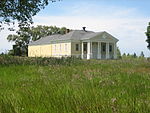Fort Lawton Air Force Station
1960 establishments in Washington (state)1963 disestablishments in Washington (state)Aerospace Defense Command military installationsGeographic coordinate listsInstallations of the United States Air Force in Washington (state) ... and 4 more
Lists of coordinatesMilitary installations closed in 1963Military installations established in 1960Semi-Automatic Ground Environment sites

Fort Lawton Air Force Station is a closed United States Air Force General Surveillance Radar station. It is located on Fort Lawton in the Magnolia neighborhood of northwest Seattle, Washington. The Air Force inactivated its unit in 1963; while the site remained under Army control until 1974. Today the Federal Aviation Administration (FAA) operates the site as part of the Joint Surveillance System (JSS).
Excerpt from the Wikipedia article Fort Lawton Air Force Station (License: CC BY-SA 3.0, Authors, Images).Fort Lawton Air Force Station
Washington Avenue, Seattle Magnolia
Geographical coordinates (GPS) Address Nearby Places Show on map
Geographical coordinates (GPS)
| Latitude | Longitude |
|---|---|
| N 47.6575 ° | E -122.41305555556 ° |
Address
Washington Avenue 654
98199 Seattle, Magnolia
Washington, United States
Open on Google Maps










